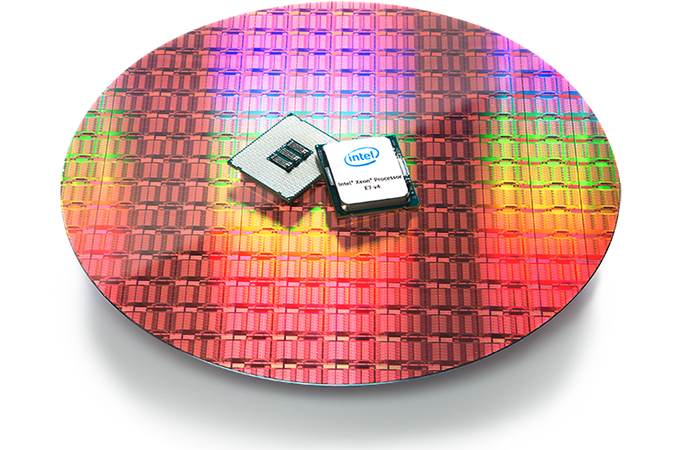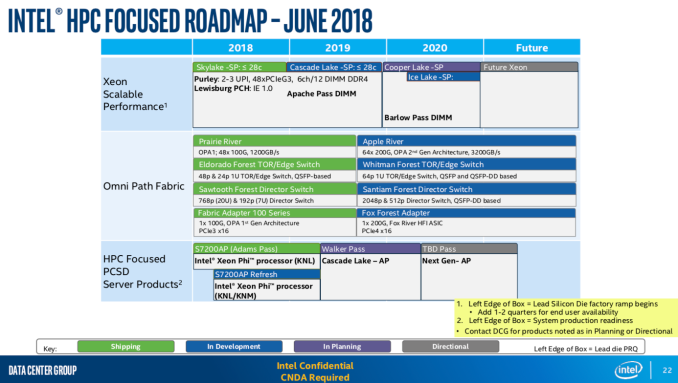Intel’s Xeon Scalable Roadmap Leaks: Cooper Lake-SP, Ice Lake-SP Due in 2020
by Anton Shilov on July 25, 2018 2:30 PM EST- Posted in
- CPUs
- Intel
- Xeon
- Enterprise CPUs
- 10nm
- Ice Lake
- Cooper Lake

Recently a Chinese university has published a collection of slide-decks from various companies covering a server/HPC event. Among the slides, Intel had a seemingly longer comprehensive presentation describing Intel’s conceptual approaches to HPC to analysis of various workloads, and most interestingly, future plans and what looks to be an up-to-date server roadmap.
According to slides published by the Central South University from Changsha City, Hunan, Intel had to delay its Ice Lake-SP server platform from 2019 to 2020 because of the general delay of its 10 nm process technology. What was unknown and newly revealed in the roadmap, is that in addition to the codenamed Ice Lake-SP processors, the company is also preparing the codenamed Cooper Lake-SP CPUs that are set to arrive a bit ahead of the Ice Lake-SP chips. The document was demonstrated to students and professors by Intel itself at a special server/HPC event earlier this month.
Both Cooper Lake-SP and Ice Lake-SP processors will support the codenamed Barlow Pass DIMMs, which is most probably Intel’s next-generation Optane DC Persistent Memory DIMM running next-gen 3D XPoint non-volatile memory (though it is a speculation at this point). Intel does not disclose the difference between the Cooper Lake-SP and the Ice Lake-SP products, but it is possible that the former is the company’s “Plan B” for next-generation servers should anything happen with its 10 nm process technology or the ICL-SP design. Meanwhile, both Cooper Lake-SP and Ice Lake-SP will belong to one server platform that will also support an eight-channel per-socket memory sub-system along with multiple OmniPath fabric innovations.
Intel expects to begin production ramp of its Cooper Lake-SP CPUs in late 2019 or early 2020 with end user availability in late Q1 2020 or mid-2020. By contrast, the Ice Lake-SP will start their ramp sometimes in late Q1 2020 and will be available in Q3 or Q4 of 2020.
Another interesting thing to point out in Intel’s roadmap is that the company is prepping the codenamed Walker Pass platform and the codenamed Cascade Lake-AP processor for the HPC market segment. The aforementioned CPU is said to replace the Xeon Phi 7200-series “Knights Landing” processor for technical computing. Meanwhile, as the name suggests, the Cascade Lake-AP will heavily rely on Skylake SP-based design for mainstream servers.
Intel traditionally does not comment on information obtained unofficially and therefore we cannot find out how accurate the current roadmap is.
Related Reading:
- Power Stamp Alliance Exposes Ice Lake Xeon Details: LGA4189 and 8-Channel Memory
- Intel’s High-End Cascade Lake CPUs to Support 3.84 TB of Memory Per Socket
- Intel Documents Point to AVX-512 Support for Cannon Lake Consumer CPUs
- Intel Begins EOL Plan for Xeon Phi 7200-Series ‘Knights Landing’ Host Processors
- Intel Shows Xeon Scalable Gold 6138P with Integrated FPGA, Shipping to Vendors
- Sizing Up Servers: Intel's Skylake-SP Xeon versus AMD's EPYC 7000 - The Server CPU Battle of the Decade?
Via: Twitter / David Shor
Source: Central South University from Changsha City, Hunan











19 Comments
View All Comments
vFunct - Wednesday, July 25, 2018 - link
Is Cooper Lake a typo of Copper Lake here? This is going to get really confusing if it isn't...Aokromes - Wednesday, July 25, 2018 - link
No.https://tpwd.texas.gov/state-parks/cooper-lake
Carl Bicknell - Wednesday, July 25, 2018 - link
Ice Lake SP Xeons still two years away? Oh boy.AMD has a serious chance now.
HStewart - Wednesday, July 25, 2018 - link
"Ice Lake SP Xeons still two years away?"Look closer at the road map, there is also Sky Lake SP and also Cascade Lake coming next year.
Keep in mind Intel does not formally release road maps. so the timing could be actually sooner.
Also Xeon processors are usually a later generation than desktop/mobile processor - but also newer functionality appears on Xeon chips first.
mczak - Wednesday, July 25, 2018 - link
From all we know, Cascade Lake is the exact same thing as the current Skylake SP, except it's fabbed on a (minimally) improved 14nm++ process. So you can expect slightly improved performance (or slightly improved efficiency), and that's it.Should AMD be able do deliver Epyc 2 on a 7nm process on time, Cascade Lake is unlikely to be competitive (at least for a wide range of applications).
(Not sure if Cooper Lake actually has any significant improvements neither.)
Cooe - Thursday, July 26, 2018 - link
That's exactly what Cascade Lake is (a 14nm++ refresh), 7nm EPYC is gonna STEAMROLL that thing lol.HStewart - Thursday, July 26, 2018 - link
Cascade Lake also has significant architecture improvements - the nm size is not all that makes up CPU designed and performance. One thing is being show that up and coming Xeon have increase memory size 3.75TB to 7.5TB range.mczak - Thursday, July 26, 2018 - link
You're certainly right that manufacturing tech isn't everything - but I'm not sure why you think Cascade Lake has significant architecture improvements. So far everything points to it being the exact same architecture as Skylake (and Kabylake for that matter). Plus some fixes and tweaks, sure (IIRC it will have Meltdown fixed and be more Spectre-resistant, so that could certainly improve performance slightly (back to previous unpatched levels...) if less workarounds are needed). And yes the differences in memory support (more memory as well as the optane stuff) may be important to users, but they do not really require architectural improvements.Samus - Thursday, July 26, 2018 - link
^^^ This.RU482 - Thursday, July 26, 2018 - link
lol, intel MOVING IN a product on a roadmap (no less a server roadmap). what a hoot. you funny guy